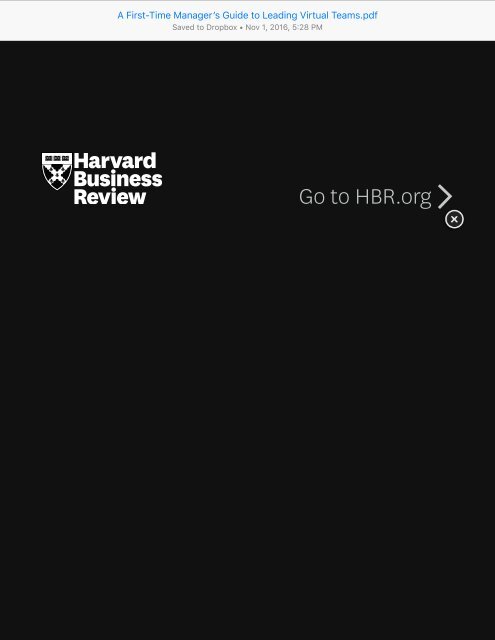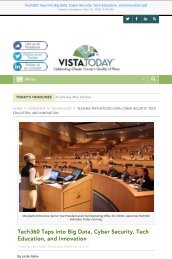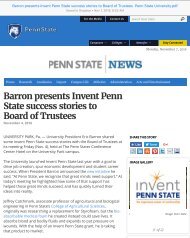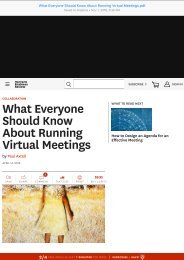A First-Time Manager’s Guide to Leading Virtual Teams
A First-Time Manager’s Guide to Leading Virtual Teams
A First-Time Manager’s Guide to Leading Virtual Teams
You also want an ePaper? Increase the reach of your titles
YUMPU automatically turns print PDFs into web optimized ePapers that Google loves.
A <strong>First</strong>-<strong>Time</strong> Managerʼs <strong>Guide</strong> <strong>to</strong> <strong>Leading</strong> <strong>Virtual</strong> <strong>Teams</strong>.pdf<br />
Saved <strong>to</strong> Dropbox • Nov 1, 2016, 5H28 PM<br />
Go <strong>to</strong> HBR.org <br />
SUBSCRIBE <br />
SIGN IN<br />
LEADING TEAMS<br />
A <strong>First</strong>-<strong>Time</strong><br />
WHAT TO READ NEXT<br />
Manager’s <strong>Guide</strong><br />
<strong>to</strong> <strong>Leading</strong> <strong>Virtual</strong><br />
<strong>Teams</strong><br />
What Everyone Should Know About<br />
Running <strong>Virtual</strong> Meetings<br />
by Mark Mortensen<br />
SEPTEMBER 25, 2015<br />
<br />
SAVE<br />
<br />
SHARE<br />
0<br />
<br />
COMMENT<br />
<br />
TEXT SIZE<br />
<br />
PRINT<br />
$8.95<br />
BUY COPIES
3/4 FREE ARTICLES LEFT REGISTER FOR MORE | SUBSCRIBE + SAVE! <br />
In the past, new managers often had the luxury of<br />
cutting their teeth on traditional collocated teams:<br />
groups of people, sitting down the hall from one<br />
another, who met up in conference rooms <strong>to</strong> hash out<br />
what they were trying <strong>to</strong> achieve and how <strong>to</strong> get there.<br />
Unfortunately, <strong>to</strong>day’s increasingly global work<br />
environment does not always afford that luxury. Many<br />
first-time managers find themselves assigned <strong>to</strong> a team<br />
of subordinates scattered far and wide.<br />
Managing a distributed team can feel overwhelming as<br />
it requires you <strong>to</strong> navigate many different types of<br />
distance: geographic, temporal, cultural, linguistic, and<br />
configurational (the relative number of members in each<br />
location). Every one of these dimensions affects team<br />
dynamics and, therefore, has an impact on effectiveness<br />
and performance as well. Daunting as that may seem,<br />
there is good news in the form of a large and everincreasing<br />
body of research and best practices on how <strong>to</strong><br />
increase your odds of success. But first, it’s important <strong>to</strong><br />
understand which aspects of team dynamics are, and<br />
are not, affected by distance.<br />
The effects of distance<br />
While all of the different types of distance listed above<br />
affect us, they do so primarily through two core<br />
mechanisms: shared identity and shared context.<br />
Understanding these will help you develop a much more<br />
targeted plan of attack for managing from afar.<br />
RECOMMENDED<br />
<strong>Leading</strong> Change: Why<br />
Transformation Efforts<br />
Fail (HBR Bestseller)<br />
LEADERSHIP & MANAGING<br />
PEOPLE HBR ARTICLE by John P.<br />
Kotter<br />
$8.95 ADD TO CART<br />
SAVE SHARE<br />
<strong>Teams</strong> at Work: Make<br />
<strong>Time</strong> for the Work That<br />
Matters (with<br />
PowerPoint)<br />
LEADERSHIP & MANAGING<br />
PEOPLE PRESS TOOLKIT by Julian<br />
Birkinshaw, Jordan Cohen<br />
$99.95 ADD TO CART<br />
Harvard Business<br />
Review, Oc<strong>to</strong>ber 2016<br />
LEADERSHIP & MANAGING<br />
PEOPLE HBR ISSUES by<br />
$16.95 ADD TO CART<br />
SAVE SHARE
FURTHER READING<br />
HBR <strong>Guide</strong><br />
<strong>to</strong> <strong>Leading</strong><br />
<strong>Teams</strong><br />
Ebook +<br />
Tools<br />
LEADING<br />
TEAMS EBOOK<br />
+ TOOLS by<br />
Mary Shapiro<br />
<strong>First</strong>, distance affects how<br />
you feel about people.<br />
Dealing with the types of<br />
distance listed above (often<br />
grouped <strong>to</strong>gether and<br />
labeled “locational”)<br />
triggers a sense of “social<br />
distance” – an unshared sense of identity, or a feeling of<br />
“us vs. them.” A lack of a shared identity has a far<br />
stronger impact on team dynamics than any of the types<br />
of distance individually. In an experimental field study I<br />
conducted with Michael O’Leary, for example, we<br />
showed that unshared identity arising from social<br />
distance increased coordination problems and reduced<br />
group cognition in the form of transactive memory.<br />
When teams function with high levels of transactive<br />
memory, they know where different knowledge is held<br />
in the team and how <strong>to</strong> access it. For instance, if<br />
everyone knows that Hec<strong>to</strong>r is a talented forecaster, the<br />
team will save time by assuming that Hec<strong>to</strong>r is<br />
responsible for any new information regarding<br />
forecasting. When transactive memory is impaired,<br />
however, the efficiency of the group suffers.<br />
Similarly, a study conducted with Pamela Hind found<br />
that this sense of us-vs.-them significantly increased<br />
levels of conflict within the global R&D teams of a<br />
Fortune 500 petroleum firm (in fact, a <strong>to</strong>p five Fortune<br />
500 company).<br />
Second, distance affects what you know about people.<br />
Catherine Cram<strong>to</strong>n refers <strong>to</strong> this concept as “the mutual<br />
knowledge problem,” but put simply, it means that you
don’t know what they know – and vice versa. Why does<br />
this matter? Because a shared sense of context, a shared<br />
understanding of not only what you do but how you do<br />
it and why, is a key driver of your ability <strong>to</strong> coordinate<br />
and collaborate. <strong>Teams</strong> with a shared understanding are<br />
more efficient. They don’t waste time ensuring<br />
everyone is on the same page and they have fewer<br />
issues with miscommunication. In the R&D team study<br />
mentioned above, we found that unshared context was<br />
a particularly strong driver of task-based conflict, or<br />
disagreements over the work being done.<br />
Taken <strong>to</strong>gether, this means that when assessing the<br />
effects of distance on your team, you need <strong>to</strong> keep in<br />
mind both how you feel, and what you know, about<br />
your distant colleagues.<br />
Though it may come as a bit of a surprise, distance<br />
doesn’t change the fundamental rules of the game. A<br />
global virtual team is first and foremost a team — just<br />
because yours is distributed doesn’t mean you should<br />
discard the prevailing wisdom about how the most<br />
effective teams operate. You need <strong>to</strong> arm yourself with a<br />
good model of team effectiveness and use it <strong>to</strong> assess<br />
and improve team dynamics and processes. A model<br />
provides structure and will help you organize your<br />
efforts as you tackle management for the first time. This<br />
is especially important for those who are dealing with<br />
the added complexities of distance.<br />
Managing the effects of distance<br />
<strong>First</strong> things first: don’t panic. Remember that global,<br />
virtual, distributed teams are composed of people just
like any other team. The more you and your team<br />
members can keep this in mind, the better your results<br />
will be. As the manager, encourage everyone <strong>to</strong> engage<br />
in some perspective taking: think about how you would<br />
behave if your roles were reversed. This is a small way<br />
of reminding your team that collaboration isn’t magic,<br />
but it does take some effort.<br />
Second, remember the basics. Arm yourself with a welltested<br />
model of team effectiveness and use it <strong>to</strong> help<br />
structure your thinking. There are, of course, many<br />
models out there. For me, J. Richard Hackman’s Team<br />
Effectiveness Model is an excellent starting point. It’s<br />
based on a massive amount of rigorous research across a<br />
wide range of teams. This model stresses the<br />
importance of the team goal. Building on Hackman’s<br />
work, my own research (paired with evidence collected<br />
in executive classrooms) shows that if you do only one<br />
thing, ensuring that the team’s goal is clear, challenging,<br />
consequential, and commonly-held yields the biggest<br />
benefit. This holds true whether your subordinates are<br />
down the hall or around the globe.<br />
In the end, being mindful about your team process is<br />
more important than which particular model you<br />
choose. Take that model and use it <strong>to</strong> assess how you’ve<br />
done, where you stand, and where you are going.<br />
Third, think (and talk) about how <strong>to</strong> overcome the<br />
negative effects that a lack of shared identity and shared<br />
context can have.<br />
To help your team combat us-vs.-them thinking,
einforce what is shared: the team’s purpose. All teams<br />
are designed <strong>to</strong> achieve something and if the team is<br />
designed well, team members depend on one another <strong>to</strong><br />
accomplish their goal. Remind your team that you are<br />
all working <strong>to</strong> the same end and that you need each<br />
other <strong>to</strong> get there. Doing so at the outset and<br />
intermittently throughout the project will help you<br />
build a strong sense of shared identity.<br />
A shared understanding comes from sharing<br />
information. Team members working at a distance need<br />
<strong>to</strong> make an effort <strong>to</strong> understand what is happening in<br />
each person’s local context. Importantly, that includes<br />
information not only about the work being done but<br />
also about the environment in which people are working<br />
(ex. structural changes, office politics, even personal life<br />
events). All of these affect the psychology of your<br />
dispersed colleagues and, therefore, how they react <strong>to</strong><br />
you and the rest of the team.<br />
One last note — it’s easy <strong>to</strong> get fixated on either<br />
information or interpersonal dynamics <strong>to</strong> the exclusion<br />
of the other but that paints an incomplete picture. You<br />
need <strong>to</strong> consider the effects of both and how they<br />
reinforce one another. I always encourage team<br />
managers <strong>to</strong> have regularly scheduled check-ins not just<br />
<strong>to</strong> measure progress <strong>to</strong>wards the team’s goal but <strong>to</strong><br />
discuss both its context (what it knows) and identity<br />
(who it is).
Mark Mortensen is an associate<br />
professor of Organisational Behaviour at<br />
INSEAD. His work focuses on the changing<br />
nature of collaboration, particularly fluid,<br />
interdependent, and global teams.<br />
This article is about LEADING TEAMS<br />
FOLLOW THIS TOPIC<br />
Related Topics:<br />
MANAGING PEOPLE<br />
UP NEXT IN LEADING TEAMS<br />
Getting <strong>Virtual</strong> <strong>Teams</strong><br />
Right<br />
by Keith Ferrazzi<br />
UP NEXT IN COLLABORATION<br />
How Successful <strong>Virtual</strong><br />
<strong>Teams</strong> Collaborate<br />
by Keith Ferrazzi<br />
UP NEXT IN MANAGING PEOPLE<br />
How <strong>to</strong> Manage Remote<br />
Direct Reports<br />
by Rebecca Knight<br />
Partner Center
Subscribe + Save!<br />
EXPLORE HBR<br />
The Latest<br />
Most Popular<br />
All Topics<br />
Magazine Archive<br />
Video<br />
Audio<br />
Webinars<br />
Subscriber Exclusives<br />
My Library<br />
Newsletters<br />
HBR STORE<br />
Article Reprints<br />
Books<br />
Cases<br />
Collections<br />
Magazine Issues<br />
HBR <strong>Guide</strong> Series<br />
HBR 20-Minute Managers<br />
HBR Must Reads<br />
Tools<br />
ABOUT HBR<br />
Contact Us<br />
Advertise with Us<br />
Subscribe<br />
Information for<br />
Booksellers/Retailers<br />
Masthead<br />
Global Editions<br />
Media Inquiries<br />
<strong>Guide</strong>lines for Authors<br />
HBR Analytic Services<br />
HBR SUBSCRIBER<br />
ASSISTANCE<br />
U.S./Canada:<br />
800.274.3214<br />
harvard@cdsfulfillment.com<br />
hbr.org/subscriberservices<br />
International:<br />
+44.1858.438.412<br />
hbr@subscription.co.uk<br />
subscription.co.uk/hbr/help<br />
Asia Pacific:<br />
+612.8296.5401<br />
India Today Group:<br />
+0120.2479945<br />
hbrcare@in<strong>to</strong>day.com<br />
hbrsasia.org<br />
HBR.ORG CUSTOMER<br />
ASSISTANCE<br />
U.S./Canada:<br />
800.988.0886<br />
International:<br />
617.783.7500<br />
Email:<br />
cus<strong>to</strong>merservice@harvardb…<br />
Cus<strong>to</strong>mer Service Help & FAQs<br />
Copyright Permissions<br />
FOLLOW HBR<br />
<br />
Facebook<br />
Twitter<br />
<br />
LinkedIn<br />
<br />
Google+<br />
Your Newsreader<br />
About Us | Careers | Privacy Policy | Copyright Information | Trademark Policy<br />
Harvard Business Publishing: Higher Education | Corporate Learning | Harvard Business Review<br />
Copyright © 2016 Harvard Business School Publishing. All rights reserved. Harvard Business Publishing is an affiliate of Harvard Business<br />
School.
















